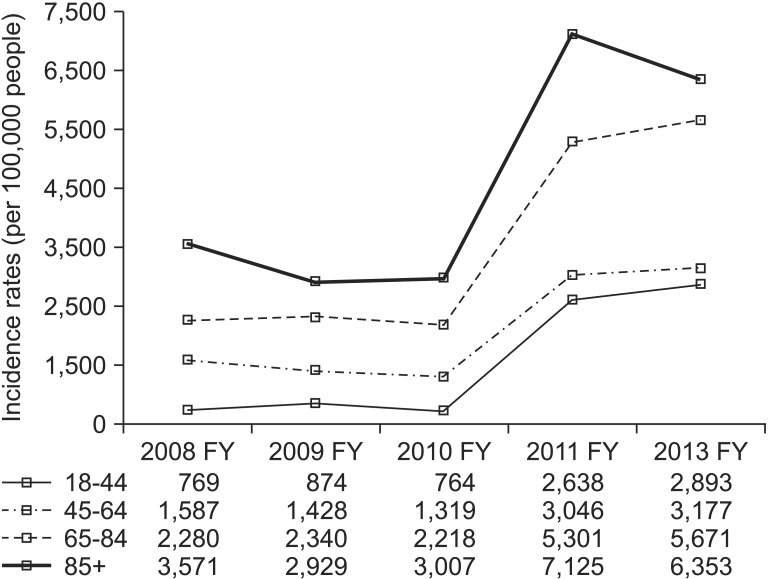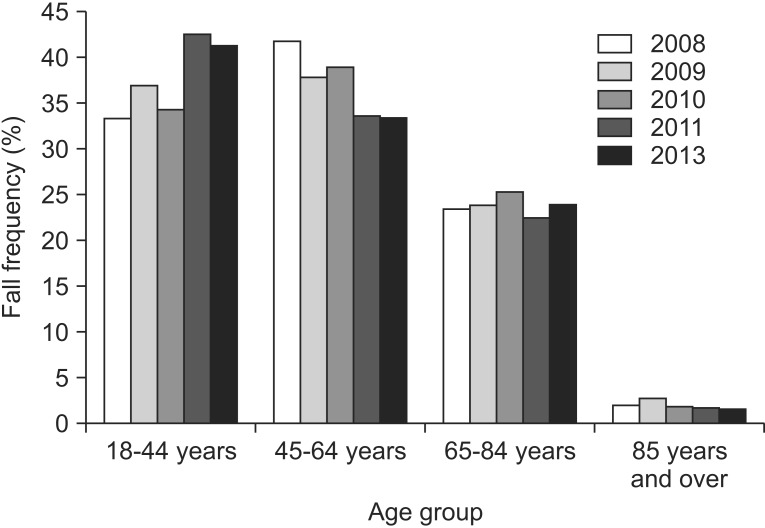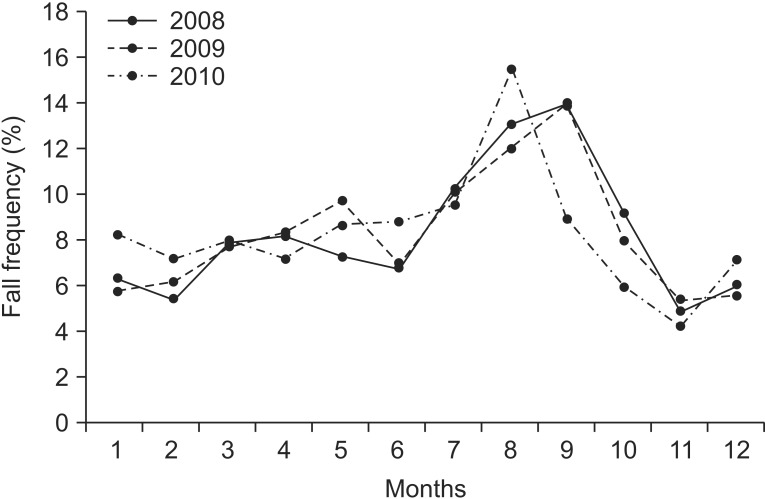Ann Rehabil Med.
2016 Aug;40(4):657-665. 10.5535/arm.2016.40.4.657.
Longitudinal Trends in Fall Accidents in Community Dwelling Korean Adults: The 2008–2013 Korean Community Health Survey
- Affiliations
-
- 1Department of Health Sciences and Research, College of Health Professions, Medical University of South Carolina, Charleston, SC, USA. hongi@musc.edu
- 2Department of Healthcare Leadership and Management, College of Health Professions, Medical University of South Carolina, Charleston, SC, USA.
- 3Department of Occupational Therapy, Wonkwang University School of Medicine, Iksan, Korea.
- KMID: 2356651
- DOI: http://doi.org/10.5535/arm.2016.40.4.657
Abstract
OBJECTIVE
To describe the longitudinal characteristics of unintentional fall accidents using a representative population-based sample of Korean adults.
METHODS
We examined data from the Korean Community Health Survey from 2008 to 2013. Univariate analysis and multivariable logistic regression were used to identify the characteristics of fall accidents in adults.
RESULTS
Between 2008 and 2013, the incidence rate of fall accidents requiring medical treatment increased from 1,248 to 3,423 per 100,000 people (p<0.001), while the proportion of indoor fall accidents decreased from 38.12% to 23.16% (p<0.001). Females had more annual fall accidents than males (p<0.001). The major reason for fall accidents was slippery floors (33.7% in 2011 and 36.3% in 2013). Between 2008 and 2010, variables associated with higher fall accident risk included specific months (August and September), old age, female gender, current drinker, current smoker, diabetes, osteoarthritis, osteoporosis, and depression. A high level of education and living with a partner were negatively associated with fall accident risk. In 2013, people experiencing more than 1 fall accident felt more fear of falling than those having no fall accidents (odds ratio [OR] for 1 fall, 2.12; 95% confidence interval [CI], 2.04-2.12; OR for more than 2 falls, 2.97; 95% CI, 2.83-3.10).
CONCLUSION
The occurrence of fall accidents has consistently increased in Korea from 2008 to 2013. Future intervention studies are needed to reduce the increasing incidence rates of fall accidents in community dwelling adults.
Keyword
MeSH Terms
Figure
Reference
-
1. Statistics Korea. Annual report on the cause of death statistics. Daejeon: Statistics Korea;2014.2. Kim YT, Choi BY, Lee KO, Kim H, Chun JH, Kim SY, et al. Overview of Korean community health survey. J Korean Med Assoc. 2012; 55:74–83.
Article3. Cho JP, Paek KW, Song HJ, Jung YS, Moon HW. Prevalence and associated factors of falls in the elderly community. Korean J Prev Med. 2001; 34:47–54.4. Lim NG, Shim KB, Kim YB, Park JL, Kim EY, Na BJ, et al. A study on the prevalence and associated factors of falls in some rural elderly. J Korean Geriatr Soc. 2002; 6:183–196.5. Shin KR, Kang Y, Hwang EH, Jung D. The prevalence, characteristics and correlates of falls in Korean community-dwelling older adults. Int Nurs Rev. 2009; 56:387–392. PMID: 19702815.
Article6. Tinetti ME, Speechley M, Ginter SF. Risk factors for falls among elderly persons living in the community. N Engl J Med. 1988; 319:1701–1707. PMID: 3205267.
Article8. Lim JY, Park WB, Oh MK, Kang EK, Paik NJ. Falls in a proportional region population in Korean elderly: incidence, consequences, and risk factors. J Korean Geriatr Soc. 2010; 14:8–17.
Article9. Korea Centers for Disease Control and Prevention. 2014 Korean Community Health Survey. Cheongju: Centers for Disease Control and Prevention;2014.10. Korea Centers for Disease Control and Prevention. Having a quick look at the regional statistics between 2008 and 2011. Cheongju: Centers for Disease Control and Prevention;2012.11. Choi EJ, Kim SA, Kim NR, Rhee JA, Yun YW, Shin MH. Risk factors for falls in older Korean adults: the 2011 Community Health Survey. J Korean Med Sci. 2014; 29:1482–1487. PMID: 25408578.
Article12. Armitage P. Tests for linear trends in proportions and frequencies. Biometrics. 1955; 11:375–386.
Article13. Kim JM, Lee MS, Song HJ. An analysis of risk factors for falls in the elderly by gender. Korean J Health Educ Promot. 2008; 25:1–18.14. Deandrea S, Lucenteforte E, Bravi F, Foschi R, La Vecchia C, Negri E. Risk factors for falls in community-dwelling older people: a systematic review and meta-analysis. Epidemiology. 2010; 21:658–668. PMID: 20585256.15. Kim JM, Lee MS. Risk factors for falls in the elderly population in Korea: an analysis of the third Korea National Health and Nutrition Examination Survey data. Korean J Health Educ Promot. 2007; 24:23–39.16. Han MA, Kim KS, Park J, Kang MG, Ryu SY. Association between levels of physical activity and poor self-rated health in Korean adults: the Third Korea National Health and Nutrition Examination Survey (KNHANES), 2005. Public Health. 2009; 123:665–669. PMID: 19854457.
Article17. Korea Ministry of Culture Sports and Tourism. Survey on citizen's sport participation 2013. Sejong: Ministry of Culture Sports and Tourism;2013.18. Korea Ministry of Culture Sports and Tourism. Survey on citizen's leisure participation 2012. Sejong: Ministry of Culture Sports and Tourism;2012.19. Stevens JA, Sogolow ED. Gender differences for non-fatal unintentional fall related injuries among older adults. Inj Prev. 2005; 11:115–119. PMID: 15805442.
Article20. Guideline for the prevention of falls in older persons. American Geriatrics Society, British Geriatrics Society, and American Academy of Orthopaedic Surgeons Panel on Falls Prevention.21. de Rekeneire N, Visser M, Peila R, Nevitt MC, Cauley JA, Tylavsky FA, et al. Is a fall just a fall: correlates of falling in healthy older persons. The Health, Aging and Body Composition Study. J Am Geriatr Soc. 2003; 51:841–846. PMID: 12757573.
Article22. Fletcher PC, Hirdes JP. Risk factors for falling among community-based seniors using home care services. J Gerontol A Biol Sci Med Sci. 2002; 57:M504–M510. PMID: 12145363.
Article23. Howland J, Peterson EW, Levin WC, Fried L, Pordon D, Bak S. Fear of falling among the community-dwelling elderly. J Aging Health. 1993; 5:229–243. PMID: 10125446.
Article24. Gillespie LD, Robertson MC, Gillespie WJ, Lamb SE, Gates S, Cumming RG, et al. Interventions for preventing falls in older people living in the community. Cochrane Database Syst Rev. 2009; 2:CD007146. PMID: 19370674.
Article
- Full Text Links
- Actions
-
Cited
- CITED
-
- Close
- Share
- Similar articles
-
- Development of a Knowledge Scale of Fall Risk Factors for Community-dwelling Older Adults
- A Structural Equation Model of Fall Prevention Behavior among Community-dwelling Older Adults with Osteoarthritis
- Fall Risk Home Environment and Fall Experiences among Community-Dwelling Older People
- Factors influencing fall in the community-dwelling elderly: Data from the 2020 national survey of older people: A secondary analysis study
- Effects of Frailty on Health-related Quality of Life of Rural Community-dwelling Elderly: Mediating and Moderating Effects of Fall-Related Efficacy and Social Support




